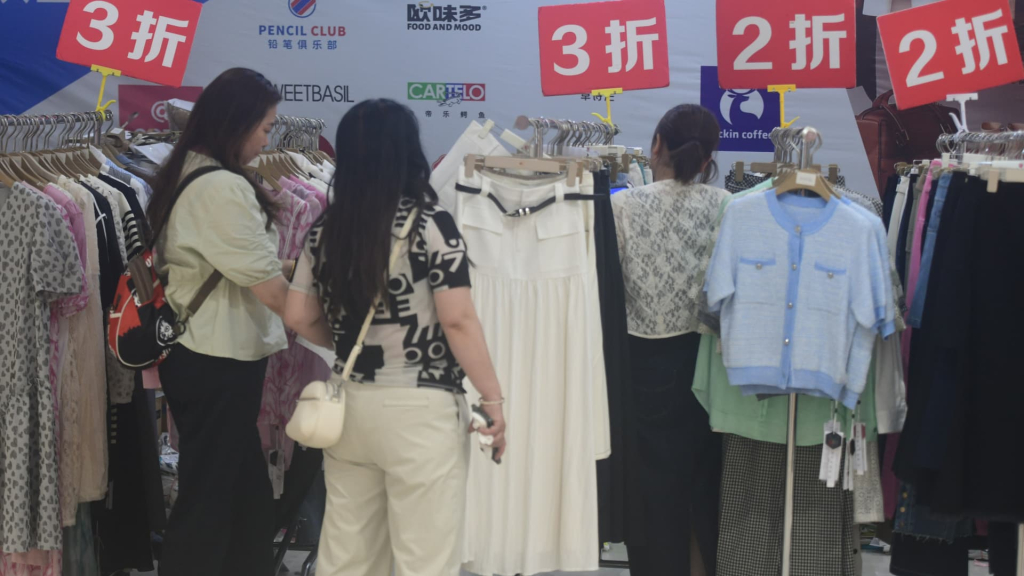BEIJING — Consumer spending in China remains stagnant, hampered by uncertainties surrounding wealth, shifting consumer behavior, and a lack of a robust social safety net.
Marked by four consecutive months of declining consumer prices and consumer confidence near historic lows, the economic landscape is further challenged by a struggling real estate market. Analysts consistently highlight one primary contributor: stagnant income levels.
According to a report by Jeremy Stevens, an Asia economist at Standard Bank based in Beijing, disposable income growth has significantly slowed since the onset of the pandemic, now averaging just 5% annually—a sharp decline from previous rates.
Wage growth has been limited, with only three out of 16 sectors—mining, utilities, and information technology services—witnessing pay increases that outpace gross domestic product growth since 2020.
Recent monthly business surveys for May indicated a contraction in the job market overall, with especially harsh impacts on factories facing U.S. tariffs. The youth unemployment rate for individuals aged 16 to 24 who are not in school remained high at 15.8% in April, while the official urban jobless rate has stabilized around 5%.
A recent survey from the People’s Bank of China revealed that a record 64% of households in the third quarter of 2024 preferred to save rather than spend or invest. This figure decreased slightly to 61.4% in the fourth quarter, yet it highlights a concerning trend of consumer caution that has persisted since late 2023.
Among those respondents who expressed intentions to increase spending, education claimed the highest priority, followed closely by health care and tourism, according to the PBOC’s fourth-quarter survey published in March.
More than half of surveyed individuals reported that they perceive the job market as either becoming more challenging or difficult to gauge.
Culturally, the Chinese have often prioritized saving, especially in the context of limited insurance coverage that forces individuals to cover the majority of health care, education, and retirement expenses. The ongoing downturn in the real estate sector has further diminished household spending, as property typically constitutes a significant portion of household wealth in China.
To encourage consumer spending, Luo Zhiheng, the chief economist at Yuekai Securities, recommends substantial increases in pension payouts via a larger portion of state assets allocated to the Ministry of Finance. He also suggests boosting public holidays and providing consumption vouchers for the service sector as potential solutions.
In recent weeks, Chinese authorities have escalated efforts to bolster employment and enhance social welfare programs. However, policymakers have refrained from implementing the mass cash handouts that were provided in the U.S. and Hong Kong to stimulate economic activity post-pandemic.
Analysts have warned that the recovery of retail sales in China will likely be slow due to unresolved uncertainties surrounding consumer behavior.
Bruno Lannes, a senior partner at Bain & Company specializing in consumer products and retail, noted that prior to the pandemic, Chinese consumers were eager to embrace new offerings. Today, he observes a significant shift towards more rational decision-making among consumers regarding their purchases.
The report on retail sales for May is due on Monday, with analysts surveyed by Reuters forecasting a slowdown in year-on-year growth to 4.9%, down from 5.1% recorded in April.
A shift out of big cities
Another contributing factor to negative consumer price index readings is the trend of Chinese consumers gravitating towards lower-priced products. This shift is partly driven by overproduction of higher-quality goods and a migration from major urban centers to more affordable locales.
According to a report from Worldpanel and Bain & Company, Shanghai lost 72,000 permanent residents in the past year, while Beijing experienced a decline of 26,000—both considered “tier 1” cities in China.
This demographic shift has resulted in significantly higher growth rates for daily necessities in smaller cities classified as “tier 3” and “tier 4,” effectively counterbalancing declines in consumption within tier 1 cities. The study indicated robust increases in the sales volume and value of packaged foods, beverages, personal care items, and household products in these regions.
Despite an overall increase in sales volume of 4.4% for such goods in China last year, average selling prices dropped by 3.4% as consumers opted for budget-friendly options and businesses increased promotional activities.
The trend extends even to the flower market, with the Kunming International Flora Auction Trading Center in Yunnan province reporting a rise in demand from lower-tier cities. This has led to higher sales volumes but lower average prices in the sector.
Li Shenghuan, a vendor near the trading center, acknowledged a slight decrease in flower prices, partly due to an increase in local flower cultivation, yet she anticipates demand to rebound around the National Day holiday in early October.
It’s notable that over the years, the disposable income of rural residents has consistently been less than half that of their urban counterparts. Recent data indicates that urban per capita disposable income stood at 54,188 yuan ($7,553) last year—substantially lower than the $64,474 recorded for the U.S. as of December.
Stevens from Standard Bank noted that the consumption-to-income ratio in rural areas has markedly increased, exceeding pre-pandemic levels, while urban household ratios have declined. He cautioned that lower-income households lack the wealth scale necessary to significantly boost consumption in the short term.
The richest 20% of households in China account for half of the nation’s total income and consumption, as well as 60% of total savings. He emphasized that policy measures aimed at supporting low-income groups, while well-intended, are insufficient without comprehensive reforms in wage structures.
Furthermore, he pointed out that the pursuit of “common prosperity” has led to institutional changes and policy adjustments that, though well-meaning, have contributed to ongoing uncertainty in the market, which has yet to establish a new equilibrium.


























